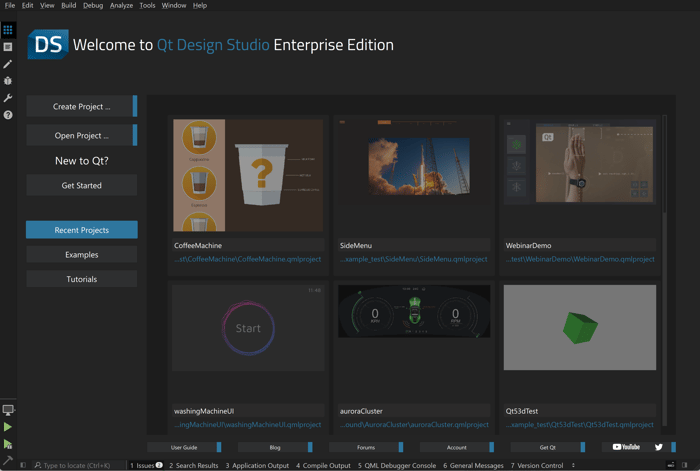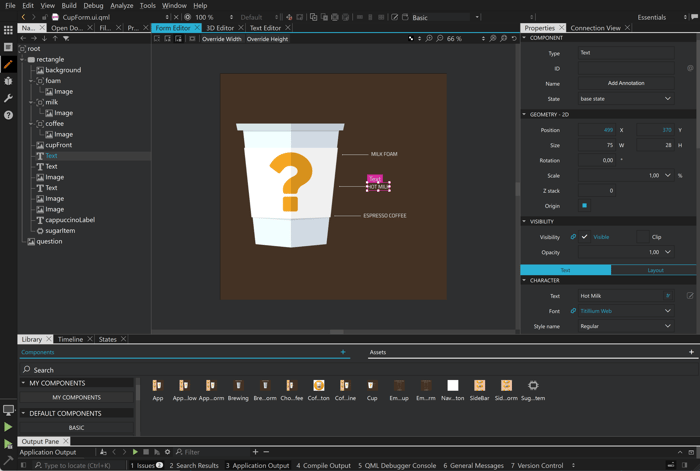We are happy to announce the release of Qt Design Studio 3.0.
Qt Design Studio is a UI design and development tool that enables designers and developers to rapidly prototype and develop complex UIs. Qt Design Studio outputs a functional user interface as code so developers can use it as-is making integration and cooperation a breeze. To get an impression, you should watch this video.
For detailed information about Qt Design Studio, visit the online documentation page.
New Licensing Model
Starting with Qt Design Studio 3.0 we introduce a new license schema. For Open Source users we keep the Community Edition without any changes.
We introduce a commercial offering separated into two products. There is the Qt Design Studio Professional, which is part of all Qt license bundles and allows you to create and update user interfaces together with 2D and 3D.
For designers requiring more advanced features, we have Qt Design Studio Enterprise Edition. This comes packed with features like import bridges, support for Simulink and multi-language editor to ease the work done in the user interface design process in larger scale projects. Additionally, the good thing about the Enterprise Edition is that it can be purchased independently, therefore the designer using Qt Design Studio Enterprise does not have to have a Qt Development license anymore. For more details of the Enterprise features, please refer to the Getting Started paragraph.
New Welcome Page
The most obvious change in Qt Design Studio 3.0 is the redesign of the Welcome Page. The new design follows our theming, has a clearer structure, and supports a responsive design for the grid view. Projects, examples, and tutorials have now descriptions and tags.

The new Welcome Page is developed by our designer in Qt Design Studio itself. For this, we created a standalone version of the Welcome Page, where the theming and backend are mocked up with QML. The standalone version is fully functional and this way the welcome page can be fully developed in Qt Design Studio. The resulting QML files are used without any changes in actual application, by simply exchanging the mockup backend with the real C++-based one.
All the examples from the Welcome Page are now downloaded on demand. This allows us to maintain the examples independently from the Qt Design Studio release cycle.
UI/UX Improvements and Bug Fixes
As always we fixed bugs and did a couple of smaller and some bigger improvements to the UI. Some superfluous UI controls and elements were removed and we fine-tuned the color theme. Another notable change is improved anti-aliasing for our studio controls like ArcItem and SvgPathItem.

Getting Started
As with the previous versions, Qt Design Studio 3.0 is also available as a free Community Edition that is part of the online installer. The Community and Professional Editions lacks Photoshop, Sketch, Figma, and Adobe XD bridges, that are included in the Enterprise Edition and also the Simulink integration and multi-language editor support.
Qt Design Studio 3.0 is available under Tools > Qt Design Studio 3.0.0 in the online installer.
You can find the latest online documentation for Qt Design Studio 3.0 here. The documentation is also available from inside Qt Design Studio.
The welcome page of Qt Design Studio contains examples and links to video tutorials to help you get started.
Of course Qt Design Studio contains many more bug fixes and small improvements. Please check the change log for more details.
Please post issues you find or suggestions you have in our bug tracker.





Commenting for this post has ended.
Thank you for making macOS usable again! (QTCREATORBUG-22123 )
Importing and parsing CMake projects is still fragile and error-prone (https://bugreports.qt.io/browse/QTCREATORBUG-24637). There are still 3 related commands under Build drop down: "Run CMake, Clear CMake Coniguration, Rescan project". If I make a mistake in the initial variables section, I need to
It would be nice to make this more robust. If initial project resolving fails and I change one of the variables, QtCreator should try to re-resolve the project in a 100% clean environment. And I would like to see a resolve button in that dialog that does exactly this.
Just a note that you can set/change variables in the configuration table after initial configuration - even if initial configuration failed. But I agree that this is not great or intuitive or anything. It is very unclear what the "Initial parameters" actually represent / when they are actually used. Some button "Clear CMake configuration and configure with initial parameters" or such would probably already help a bit.
Thanks, but as already written in the bug report: if project resolving fails again, all values are removed from the configuration table (still happens in 4.15 beta).
IMO the parameters in the "initial CMake parameters" field should be read-only or should be synced back and forth with the the kit configuration. If I change those variables in the kit later on, the project falls out of sync. That's annoying.
Take Qbs project resolving in Qt Creator as an example. It's way more robust, less error-prone and easier to use.
QtCreator still can't show output (qDebug(), Log.i(), etc.) from Qt Android Service processes. It would be handy to have this in 'Application Output' (maybe dedicated output window for each process of application). https://bugreports.qt.io/browse/QTCREATORBUG-24496, https://bugreports.qt.io/browse/QTCREATORBUG-16887